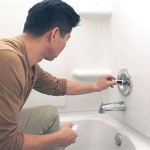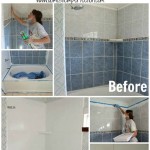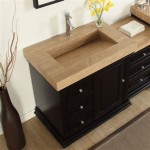How to Replace Bathroom Wall Tile
Replacing bathroom wall tile is a significant home improvement project that can refresh the look and feel of your bathroom. It involves a combination of demolition, preparation, installation, and finishing work. While it can be a challenging task, by following the correct steps and safety precautions, you can achieve professional results. This article provides a comprehensive guide to replacing bathroom wall tile, outlining the necessary steps and procedures.
1. Planning and Preparation
Before embarking on the tile replacement process, careful planning and preparation are essential for a successful outcome. This step involves assessing the existing tile, determining the new tile selection, gathering necessary materials, and preparing the work area.
a) Assess the Existing Tile
Begin by inspecting the existing tile to identify its condition and attachment method. Note any loose or damaged tiles that need to be removed. Determine if the existing tile is adhered directly to the wall or on top of a backer board. This information will influence the removal and installation processes.
b) Select New Tile
Consider the style, color, size, and material of the new tile. Explore different options to find a design that complements your bathroom's décor and complements the existing fixtures. Ensure the new tile is compatible with the bathroom environment, considering factors like moisture resistance and durability.
c) Gather Materials
Once the tile selection is made, gather the necessary materials, including: * New tile * Mortar * Thin-set mortar * Grout * Tile spacers * Trowel * Notched trowel * Tile cutter or wet saw * Level * Tape measure * Sponge * Bucket * Safety gear (gloves, goggles, and dust mask)
d) Prepare the Work Area
Clear the bathroom of all furniture and fixtures. Cover the floor with a drop cloth to protect it from debris. If necessary, remove any existing fixtures, such as towel rods or soap dishes, that may hinder the tile replacement process. Ensure adequate lighting and ventilation in the work area.
2. Tile Removal
The next step is to remove the existing tile. This process requires careful attention to avoid damaging the wall beneath the tile.
a) Remove Loose Tiles
Start by removing any loose or damaged tiles. Use a hammer and chisel to carefully pry them off the wall, taking care not to damage the surrounding tiles. If the tile is adhered directly to the wall, it may be necessary to use a utility knife to score the grout lines before prying.
b) Remove Grout
Once the loose tiles are removed, use a grout removal tool or a utility knife to remove the grout from the remaining tile. Work carefully to avoid damaging the existing tile.
c) Remove Adhesive
After removing the grout, use a scraper or a putty knife to remove the adhesive or thin-set mortar holding the tile in place. This step may require some effort, and it's important to be patient and avoid damaging the wall. If the adhesive is stubborn, consider using a heat gun to soften it before scraping.
3. Wall Preparation
After removing the existing tile, prepare the wall for the new tile installation. This step involves ensuring a smooth, clean, and level surface.
a) Clean the Wall
Thoroughly clean the wall using a damp cloth and mild detergent. Remove any dust, debris, or residue from the previous tile installation. Allow the wall to dry completely before proceeding.
b) Patch and Repair
Inspect the wall for any damage or imperfections that need to be repaired. Fill any holes, cracks, or uneven surfaces with a patching compound. Allow the patching compound to dry completely before proceeding.
c) Install Backer Board (Optional)
If the existing wall is not suitable for direct tile installation, consider installing a backer board. This provides a more stable and moisture-resistant surface for the new tile. Secure the backer board to the wall using screws or adhesive.
d) Apply Waterproof Membrane (Optional)
For wet areas like showers or tubs, apply a waterproof membrane to the wall to prevent water damage. This membrane can be applied directly to the wall or over a backer board. Allow it to dry completely before proceeding.
4. Tile Installation
Once the wall is prepared, begin installing the new tile. This process requires careful attention to spacing, leveling, and alignment.
a) Mix Mortar
Follow the manufacturer's instructions to mix the mortar. Aim for a consistent and smooth consistency. Do not overmix, which can weaken the mortar.
b) Apply Mortar to Wall
Using a notched trowel, apply a layer of mortar to the wall, working in small sections. The size of the notches on the trowel will determine the thickness of the mortar layer, which should be based on the tile's thickness.
c) Install Tile
Start installing the tile from a corner or a reference point. Press each tile firmly into the mortar, ensuring it is level and aligned with the surrounding tiles. Use tile spacers between the tiles to ensure even spacing.
d) Clean Excess Mortar
Immediately clean any excess mortar from the tile surface using a damp sponge. If the mortar dries too quickly, it may be difficult to remove.
5. Grouting
After the tile has dried, apply grout to the spaces between the tiles. This step is crucial for completing the tile installation and preventing water penetration.
a) Mix Grout
Follow the manufacturer's instructions to mix the grout. Aim for a consistent and smooth consistency. Do not overmix, as this can weaken the grout.
b) Apply Grout
Apply a thin layer of grout to the spaces between the tiles using a rubber grout float. Work the grout into the spaces, ensuring even coverage.
c) Clean Excess Grout
Immediately clean any excess grout from the tile surface using a damp sponge. Work quickly and carefully to avoid drying the grout, which can make it difficult to remove.
d) Allow Grout to Dry
Allow the grout to dry completely before proceeding to the next step. The drying time may vary depending on the type of grout used.
6. Finishing Touches
Once the grout has dried, complete the tile replacement process by applying sealant and reinstalling fixtures.
a) Apply Sealant
Apply sealant to the grout lines to prevent water penetration and staining. Follow the manufacturer's instructions for the application and drying time.
b) Reinstall Fixtures
Reinstall any fixtures that were removed during the tile removal process. Ensure they are securely attached to the wall.
7. Clean Up
After completing the tile replacement project, clean up the work area thoroughly. Dispose of any debris properly. Remove all protective coverings and dispose of them responsibly. Finally, admire your newly renovated bathroom.

Easy Diy Guide On Removing Tiles From Walls Fantastic Handyman Au

How To Remove Replace One Bathroom Tile Ceramic Repair

How To Renovate Bathroom Without Removing Tiles Multipanel

The Best Way To Remove Old Shower Tile

How To Prep And Install Diy Bathroom Shower Tile Lowe S

How To Tile A Bathroom Wall Granada Cement Blog Ideas Tips And More

Preparing Walls For Tiling Removing Old Tiles Bathroom Guru

How To Install Tile On The Bathroom Wall Step By

How To Upgrade Bathroom Tile Without Replacing

How To Install Wall Tile In Bathroom Howtospecialist Build Step By Diy Plans
Related Posts







